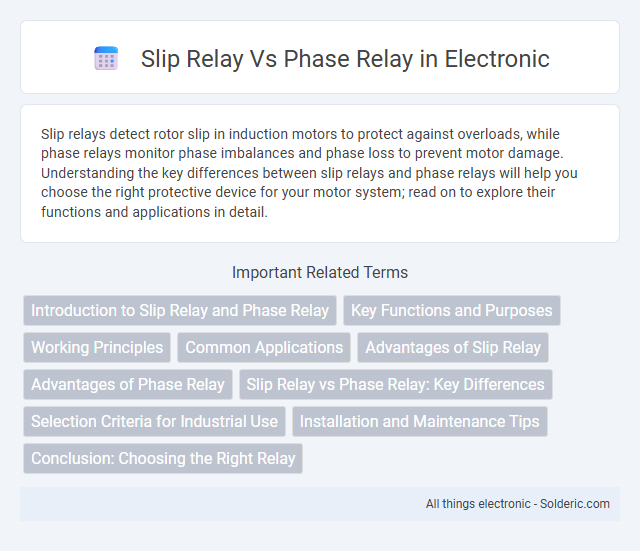Slip relays detect rotor slip in induction motors to protect against overloads, while phase relays monitor phase imbalances and phase loss to prevent motor damage. Understanding the key differences between slip relays and phase relays will help you choose the right protective device for your motor system; read on to explore their functions and applications in detail.
Comparison Table
| Feature | Slip Relay | Phase Relay |
|---|---|---|
| Function | Measures slip or difference between rotor and stator speed in motors | Detects phase presence, phase sequence, or phase failure in power systems |
| Application | Used in induction motor protection and control | Used in phase monitoring for generators, motors, and transformers |
| Operation | Operates based on slip frequency variation | Operates based on phase voltage or current detection |
| Protection Type | Protects against slip abnormality and motor stalls | Protects against phase loss, phase sequence errors, and unbalanced voltages |
| Typical Output | Relay trips or signals on abnormal slip detection | Relay trips or signals on phase fault detection |
| Common Industries | Industrial motor control, manufacturing plants | Power distribution, electrical utilities, motor control centers |
Introduction to Slip Relay and Phase Relay
Slip relay measures rotor speed slip in induction motors to detect load changes and motor abnormalities, ensuring efficient motor operation through slip-based control. Phase relay monitors phase angles and phase sequence in three-phase power systems, protecting equipment from phase loss, phase imbalance, and incorrect phase sequence. Both relays enhance motor protection but focus on different electrical parameters for system reliability.
Key Functions and Purposes
Slip relays primarily protect motors by detecting excessive slip between the rotor and stator, preventing damage from mechanical overload or stalling. Phase relays monitor phase conditions such as phase loss, phase reversal, and phase imbalance to ensure the motor runs smoothly and avoids electrical faults. Your choice depends on whether you need to safeguard against mechanical issues with a slip relay or electrical phase abnormalities with a phase relay.
Working Principles
Slip relays operate based on the time delay created by the relative motion between a moving contact and a metal disc induced by current flow, allowing for precise timing in protection circuits. Phase relays function by detecting the phase difference between two currents or voltages, tripping the circuit when the phase angle deviates beyond a set threshold, ensuring accurate fault detection. Understanding these working principles helps you select the appropriate relay for protection schemes requiring time-based coordination or phase angle monitoring.
Common Applications
Slip relays are commonly used in motor protection for detecting rotor slip and preventing damage due to mechanical overload or stalled rotors in large induction motors. Phase relays find widespread applications in monitoring phase sequence, phase imbalance, and phase failure to protect three-phase electrical systems and ensure proper motor operation. Your choice depends on whether the focus is on slip detection in motors or on maintaining phase integrity in three-phase systems.
Advantages of Slip Relay
Slip relays offer superior protection against motor stalling by accurately detecting slip between the rotor speed and synchronous speed, preventing mechanical damage and overheating. Their sensitivity to slip currents allows for early fault detection, ensuring efficient operation and minimizing downtime in industrial motors. You benefit from enhanced motor longevity and reduced maintenance costs when using slip relays compared to phase relays.
Advantages of Phase Relay
Phase relays offer superior accuracy in detecting phase imbalances, providing reliable protection for three-phase motors and electrical systems. You benefit from faster response times and enhanced fault detection, minimizing motor damage and reducing downtime compared to slip relays. Their sensitivity to phase loss and phase reversal ensures efficient monitoring, making phase relays ideal for critical industrial applications.
Slip Relay vs Phase Relay: Key Differences
Slip relays detect and respond to a reduction in motor speed caused by overloads or mechanical failures, triggering protective shutdown to prevent damage. Phase relays monitor phase sequence and voltage presence, protecting three-phase motors from phase loss, phase reversal, or unbalanced voltage conditions. While slip relays focus on speed-related issues, phase relays ensure proper phase conditions, providing complementary motor protection functions.
Selection Criteria for Industrial Use
Slip relays are ideal for applications requiring precise motor starting and overload protection, as they respond to current imbalances and slip speed variations. Phase relays are better suited for monitoring phase loss, phase sequence, and phase voltage imbalances, ensuring motor protection against phase failure and single-phasing conditions. Your industrial setup demands choosing slip relays for slip monitoring in motor control circuits and phase relays for reliable phase detection and protection.
Installation and Maintenance Tips
Slip relays require careful alignment during installation to ensure accurate detection of slip between rotor and stator speeds, while phase relays must be connected to precise phase angle inputs for proper operation. Maintenance for slip relays involves regular inspection of mechanical parts and calibration to prevent drift, whereas phase relays demand periodic verification of electrical connections and phase angle accuracy. Your choice of relay should consider the ease of access for maintenance and the specific electrical environment of your system.
Conclusion: Choosing the Right Relay
Selecting the right relay depends on your specific application requirements, as slip relays are ideal for detecting rotor slip in motors, providing precise protection against mechanical faults. Phase relays effectively monitor phase imbalances and phase loss, ensuring electrical system stability and preventing damage from overheating or phase failure. Evaluate your system's needs carefully to ensure your protective relay choice optimizes performance and safety.
slip relay vs phase relay Infographic

 solderic.com
solderic.com